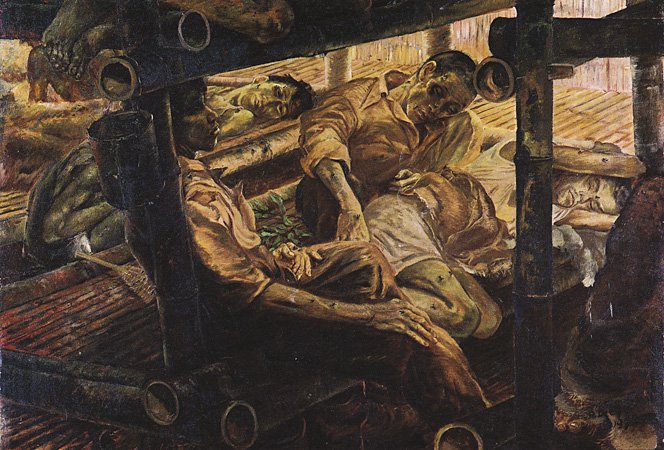Cultural Center of the Philippines
ENCYCLOPEDIA OF
PHILIPPINE ART
Capas
1948 / Oil on canvas / 86.4 x 116.8 centimetres / Artist: Demetrio Diego / National Museum of the Philippines Collection
During his lifetime, Demetrio Diego (active 1920s to the 1970s) had an outstanding career as illustrator, cartoonist, and painter. He worked as illustrator of the Tribune and Taliba in the 1920s and was chief artist of the Sunday Times Magazine from the 1950s to the 1970s. He also did the editorial cartoons of the Daily Mirror in the 1950s. As an illustrator, his lines were refined but dynamic. His editorial cartoons were witty, often utilizing plays on words. In painting, Santiago Pilar describes his lines as vigorous and his brushworks as bold, qualities that made Victorio Edades regard him “as a potential modernist and enlisted him as one of the thirteen moderns” (Pilar 1994, 338).
Diego’s Capas was done in 1948, three years after World War II ended and is considered as one of the most poignant renditions of wartime suffering. It won second place in the first postwar competition of the Art Association of the Philippines in 1948. The work is an intimate look at the sufferings Filipino soldiers had to go through when, together with American prisoners of war, they were made to march from Bataan to Camp O’Donell in Capas, Tarlac. Known as the Bataan Death March, this event in history is remembered for the atrocities committed against Filipino and American prisoners of war by Japanese soldiers. Diego’s work shows dying soldiers lying on bamboo cots in an internment camp in Capas. The work provides an intimate view of the scene, giving the feeling of being in the same room with these soldiers. The tight grouping of the figures as well as the angle of the composition highlights the cramped and uncomfortable situation. The soldiers’ faces are sunken, their eyes dark and hollow. Succumbing to fatigue, hunger, illness, and injuries, these soldiers will probably not make it. Depicted in somber colors of light and dark brown, the scene evoked is one of darkness and melancholy. This work remains significant today because it satisfies our need for temporal anchoring by capturing an important moment in history with unflinching pathos.
Written by Helen Yu-Rivera (2018)
Source
Pilar, Santiago A. 1994a. CCP Encyclopedia of Philippine Art, Vol IV, Philippine Visual Arts. Manila: Cultural Center of the Philippines.
